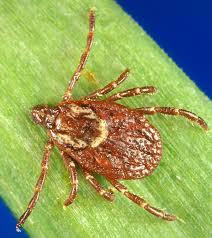 ROCKY MOUNTAIN WOOD TICK (Dermacentor andersoni)
ROCKY MOUNTAIN WOOD TICK (Dermacentor andersoni) In Montana, tick season lasts from the onset of warmer weather in the spring until about mid-July when warmer weather and low relative humidity cause the ticks to become inactive. There are many species of ticks capable of transmitting a variety of bacterial, viral, and parasitic illnesses to humans and other mammals. The Rocky Mountain wood tick is the most common disease vector in Montana and a soft-bodied tick that can transmit Relapsing Fever has also been found in Montana. Blacklegged ticks or deer ticks that are the primary vectors for Lyme disease are not found in Montana. Lyme’s disease, Babesiosis, Q-fever, Giardia, encephalitis, brucellosis, tularemia, relapsing fever, Rocky Mountain spotted fever, and the plague are all diseases that can be transmitted via tick bites. Colorado tick fever, once considered a rare disease in Montana, has been on the rise over the last few years with several positive cases identified in 2020-2021. The most common symptoms of tick-borne infections include fever and chills, aches and pains, rash, and fever of varying degrees. Although most tick-borne illnesses can be treated with antibiotics, they can be quite difficult to diagnose. Timely and proper removal of attached ticks can reduce the likelihood of a tick transmitting a tick-borne illness.
Rocky Mountain Spotted Fever
Colorado Tick Fever (performed at the CDC Rickettsia Laboratory)
Q fever
Brucella
Tularemia
Lyme
Babesia sp.
Bartonella sp.
Borrelia burgdorferi (lyme confirmation)
Borrelia hermsii (tick borne relapsing fever)
Erhlichia sp.
Rickettsia sp.
Serological tests such as ELISA and IFA measure the human immune response to tick-borne diseases and are performed at the Montana Public Health Laboratory. Although these tests are useful to detect the serologic response of a patient who has been exposed to infectious agents, a four-fold increase in titer between the acute and convalescent sera is needed to be indicative of disease. Signs and symptoms of the patient as well as the date of onset is required for testing.
Currently, PCR and culture methods are not used at MPTHL for the purposes of identifying a tick-borne illness.
The two major vectors of Rickettsia rickettsii, the bacteria responsible for Rocky Mountain spotted fever in the United States, are the Rocky Mountain wood tick Dermacentor andersoni and the American dog tick, D. variabilis.
 ROCKY MOUNTAIN WOOD TICK (Dermacentor andersoni)
ROCKY MOUNTAIN WOOD TICK (Dermacentor andersoni)
Where Found: Rocky Mountain states. Transmits: Rickettsia rickettsii (Rocky Mountain spotted fever), Colorado tick fever virus (Colorado tick fever), and Francisella tularensis (tularemia). Comments: Adult ticks feed primarily on large mammals. Larvae and nymphs feed on small rodents. Adult ticks are primarily associated with pathogen transmission to humans.
 AMERICAN DOG TICK ( Dermacentor variabilis)
AMERICAN DOG TICK ( Dermacentor variabilis)
Where found: Widely distributed east of the Rocky Mountains. Also occurs in limited areas on the Pacific Coast. Transmits: Rickettsia rickettsii (Rocky Mountain spotted fever), and Francisella tularensis (tularemia). Comments: The highest risk of being bitten occurs during spring and summer. Dog ticks are sometimes called wood ticks. Adult females are most likely to bite humans.
Sources: